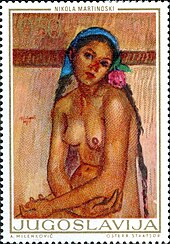Nikola Martinoski

Nikola Martinoski (born Nicolache Martin; Aromanian: Nicola Martinoschi,[1] Macedonian: Никола Мартиноски; 18 August 1903 – 7 February 1973), sometimes spelled Martinovski (Aromanian: Martinovschi,[2] Macedonian: Мартиновски), was a Macedonian Yugoslav painter of Aromanian ethnicity.[3] He is considered as a founder of contemporary Macedonian art.[4] Martinoski is best known for his painting titled Mother with Child, which, although first created in the 1930s, was not completed until the 1960s. He is also known as "The Doctor" for the many paintings he donated to modern art.[5]
Early life

Martinoski was born Nicolache Martin in 1903 to an Aromanian family in Kruševo (Aromanian: Crushuva; at the time part of the Ottoman Empire).[6] He developed an interest in painting at a young age and attended art classes in the workshop of Dimitar Andonov-Papradinski, an icon painter in Skopje. Prior to 1921, he was constantly on the move. Finally, Nikola settled down in Bucharest, Romania and attended the Academy of Fine Arts, now known as the Bucharest National University of Arts, from which he graduated in 1927.[7]
Years in Paris
Martinoski spent two years (1927–1928) in
Life in Skopje


Martinoski came back to Skopje brimming with
His first individual
Martinoski died on 7 February 1973, at the age of sixty-nine in Skopje, then in Yugoslavia. He gave sixty-two of his paintings to Kruševo as a parting gift. His home in Kruševo is now a gallery where a small number of his works are exhibited.[8]
Centenary of Martinoski's birth
In 2003, the
Painting style
Many of Martinoski's works were greatly influenced by medieval fresco art and modern Parisian school crisscross. However, his strongest artistic creations were portraits.[5]
References
- ^ LIMBA SHI CULTURA A ARMÃNJLOR TI CLASA VIII nau anj educatsii primarã. p. 15. (in Aromanian)
- ^ Bana Armâneascâ, Nr. 1/2 (43/44), 2006. p. 14. (in Aromanian)
- ^ "Life". Nikola Martinoski. Archived from the original on 21 September 2013. Retrieved 3 July 2013.
- ^ "Nikola Martinovski Biography". GRAL Gallery. Retrieved 3 July 2013.
- ^ a b Kulturen život, Volume 33. Skopje, Macedonia: Kulturno-prosvetnata zaednica na Makedonija. 1988. p. 32.
- ISBN 978-1-78035-628-0.
- ^ a b c "Work". Nikola Martinoski. Archived from the original on 21 September 2013. Retrieved 3 July 2013.
- ^ a b "Exhibition of Previously Unseen Works by Nikola Martinoski". Culture: Republic of Macedonia. Archived from the original on 21 October 2013. Retrieved 3 July 2013.
